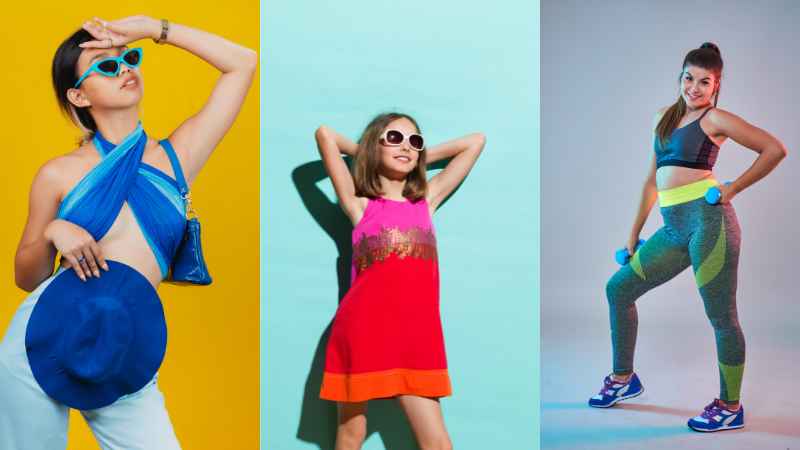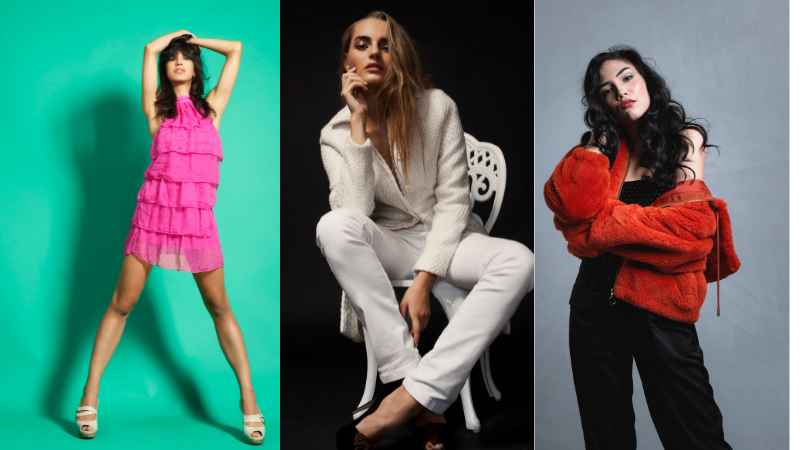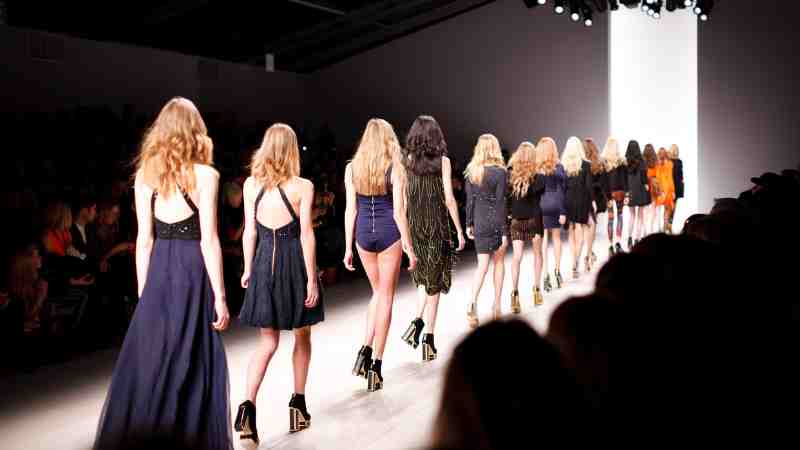Definition of Fashion: Fashion is a dynamic and ever-evolving cultural phenomenon that encompasses clothing, accessories, hairstyles, and even attitudes. It is a reflection of the prevailing styles, tastes, and values of a particular era or society. Fashion goes beyond mere clothing; it is a form of self-expression, a means of communication, and a way for individuals and communities to convey their identity, status, and aspirations. The concept of fashion encompasses not only what people wear but also how they wear it and why.

Importance of Studying Fashion Evolution: The study of fashion evolution is of significant importance for several reasons:
- Cultural Insight: Fashion provides a unique lens through which we can understand the history, values, and social dynamics of different cultures and time periods. Changes in fashion often parallel shifts in society, politics, and technology.
- Artistic Expression: Fashion is an art form in its own right. It showcases the creativity and innovation of designers, craftsmen, and wearers. Examining its evolution helps us appreciate the artistic aspect of clothing and accessories.
- Economic Impact: The fashion industry is a major global economic driver, influencing trade, manufacturing, retail, and employment. Understanding how fashion has evolved is essential for those involved in this industry and for economists analyzing consumer behavior.
- Social Commentary: Fashion often serves as a commentary on social issues and movements. By studying its evolution, we can gain insights into issues like gender roles, class distinctions, and activism.
- Personal Identity: Fashion plays a crucial role in how individuals express their identity and self-image. Examining its history helps us understand why people make certain fashion choices and how these choices relate to their personal stories.
Purpose and Scope of the Paper:
The purpose of this paper is to delve into the rich tapestry of fashion’s history and evolution, tracing its transformative journey through different epochs and cultures. By examining the development of fashion from prehistoric times to the contemporary era, we aim to uncover the underlying influences, innovations, and societal shifts that have shaped the world of clothing and style.
The scope of this paper will encompass a comprehensive exploration of fashion evolution, including its roots in prehistoric cultures, its development in ancient civilizations such as Mesopotamia, Egypt, Greece, and Rome, its evolution through the medieval and Renaissance periods, and its transformations in the 18th, 19th, and 20th centuries. Additionally, we will delve into the cultural and social influences on fashion, the role of fashion icons and designers, and the impact of globalization and sustainability on modern fashion. Through this study, we seek to provide a holistic understanding of the fascinating journey of fashion across time and space.
Prehistoric Fashion
Clothing Materials and Styles:
In the earliest chapters of human history, clothing served as a vital necessity for protection from the elements. Prehistoric fashion was characterized by its simplicity and functionality. The resources that were available and the climate of the areas that early humans inhabited had an impact on the clothing materials and styles used during this time.
- Primitive Materials: Prehistoric clothing was primarily made from natural materials like animal hides, fur, leaves, and plant fibers. Animal skins and fur provided warmth and protection, while leaves and plant fibers were woven or tied to create rudimentary garments.
- Minimalist Designs: Clothing during this era was basic and utilitarian. It consisted of simple draped or wrapped garments, such as loin cloths, capes, and skirts. The design was dictated by the need for mobility and practicality.

Cultural Significance of Early Fashion:
While prehistoric fashion may appear rudimentary compared to modern standards, it held profound cultural significance for early human societies.
- Protection and Survival: Clothing was essential for survival in diverse environments. Animal hides and fur not only shielded individuals from harsh weather conditions but also provided protection against predators and physical injuries.
- Identity and Social Roles: Even in these early stages of human development, clothing was used to distinguish social roles and group affiliations. Variations in clothing styles and adornments likely signified age, gender, and tribal or clan affiliations.
- Ritual and Belief: Clothing played a role in religious and ritual practices. Early humans used body paint, feathers, and other decorative elements to signify spiritual connections and rituals, demonstrating the cultural and spiritual significance of fashion.
Evolutionary Developments in Prehistoric Fashion:
Prehistoric fashion evolved gradually over thousands of years, reflecting the changing needs and technological advancements of early societies.
- The Discovery of Sewing: One significant development in prehistoric fashion was the invention of sewing. The ability to sew animal hides together with bone or plant-based needles and threads allowed for more tailored and fitted clothing, increasing comfort and warmth.
- Regional Variation: Different regions and climates influenced the types of materials used for clothing. In colder regions, fur and layered clothing became more common, while in warmer areas, lightweight materials and minimalistic designs prevailed.
- Emergence of Adornments: As human societies developed, so did their artistic expressions. Prehistoric fashion saw the introduction of rudimentary adornments like beads, shells, and feathers, which were used for personal decoration and cultural expression.
- Symbolism and Identity: As human societies became more complex, clothing began to symbolize cultural identity, status, and roles within the community. The colors, patterns, and materials used in clothing conveyed specific meanings.
Ancient Civilizations-Mesopotamia
Clothing in Mesopotamia:
Mesopotamia, often referred to as the “cradle of civilization,” was home to ancient societies like the Sumerians, Akkadians, and Babylonians. In Mesopotamia, clothing was both functional and a reflection of social status. Common garments include:
- Tunics: Both men and women wore simple, knee-length tunics made from wool or linen. These tunics were often belted at the waist.
- Cloaks: Cloaks or shawls made from wool or linen provided protection from the sun and cold weather.
- Footwear: Sandals or leather shoes were worn for protection and comfort.
Influences on Fashion from Mesopotamia:
Mesopotamian fashion had a lasting impact on subsequent civilizations, influencing styles in the Mediterranean and beyond. Some key influences include:
- Zigzag Patterns: Mesopotamian textiles featured intricate zigzag patterns that later appeared in Egyptian and Greek fashion.
- Braiding and Embroidery: Techniques such as braiding and embroidery, commonly used in Mesopotamian clothing, found their way into other cultures.
- Use of Color: Mesopotamian fashion incorporated vibrant colors and dyed fabrics, setting a precedent for color use in clothing.
Ancient Egypt—Clothing in Ancient Egypt:
Ancient Egypt is renowned for its rich and distinctive fashion. Clothing in ancient Egypt was not only functional but also highly symbolic.
- Linen Garments: Linen, a readily available material, was the primary fabric used for clothing. It was comfortable and suitable for the Egyptian climate.
- Kilts and Dresses: Men typically wore knee-length kilts, while women wore ankle-length sheath dresses. The style and quality of clothing varied with one’s social status.
- Jewelry: Egyptians adorned themselves with jewelry made from precious metals, gemstones, and beads.
Symbolism in Egyptian Fashion:
Egyptian fashion was laden with symbolism, reflecting religious and societal beliefs.
- Hierarchical Dress: The style and quality of clothing signified one’s social status and profession. Pharaohs and priests, for example, wore distinct garments.
- Jewelry and Amulets: Jewelry was not only decorative but also believed to offer protection and blessings.
- Headdresses: Elaborate headdresses, like the Nemes crown and the Pschent, symbolized the pharaoh’s power and divine authority.

Greece and Rome
Clothing in Ancient Greece: Ancient Greek fashion was marked by simplicity, functionality, and a focus on the human body’s natural form.
- Chitons and Peplos: Greeks wore garments like the chiton (a tunic) and the peplos (a draped dress) made from wool or linen.
- Sandals: Greeks favored open-toed sandals.
Clothing in Ancient Rome: Roman fashion drew inspiration from Greek styles but evolved to be more structured and elaborate.
- Togas and Tunics: Romans draped themselves in togas for formal occasions and wore tunics for everyday life.
- Stola and Palla: Roman women wore the stola, a long, pleated dress, and the palla, a draped shawl.
Influence of Greek and Roman Fashion on Later Periods
The fashion of ancient Greece and Rome left a significant imprint on later periods.
- Neoclassical Revival: The Renaissance era saw a revival of classical Greek and Roman styles, influencing European fashion and art.
- Toga Parties and Academic Attire: Togas are still associated with ancient Roman fashion and are used in modern contexts like toga parties and academic ceremonies.
The fashion of these ancient civilizations not only shaped the aesthetics of their time but also left an enduring legacy that continues to influence contemporary fashion and design.
Medieval and Renaissance Fashion in Medieval Europe
Clothing in the Middle Ages:
The medieval period in Europe, spanning roughly from the 5th to the 15th centuries, was marked by distinctive and hierarchical clothing styles:
- Feudal Hierarchy: Clothing was a clear marker of social status, with sumptuary laws regulating what different classes could wear.
- Tunics and Gowns: Men typically wore tunics, while women donned long gowns with varying layers and decorative elements.
- Head Coverings: Head coverings, such as hoods, coifs, and veils, were common for both men and women.
Role of the Church in Fashion:
The medieval Church exerted significant influence over fashion.
- Religious Vestments: Clergy and members of religious orders wore specific vestments, like cassocks and chasubles, reflecting their ecclesiastical roles.
- Moral Codes: The Church promoted modesty and simplicity in clothing as expressions of piety. Extravagant attire was often discouraged.
- Religious Symbols: Clothing and accessories often featured religious symbols, such as crosses and images of saints.
Renaissance
Revival of Classical Styles:
The Renaissance, spanning the 14th to the 17th centuries, saw a resurgence of interest in classical Greek and Roman culture. This revival influenced fashion in profound ways:
- Humanism: Renaissance humanism celebrated the individual, leading to a shift in clothing styles that emphasized the body’s natural proportions.
- Clothing Reforms: Fashion became more tailored and fitted, with garments like doublets and hose for men and corsets and farthingales for women.
- Use of Luxurious Fabrics: Renaissance fashion favored luxurious fabrics such as silk, satin, and velvet, often in vibrant colors.
Influence of Art and Culture on Fashion:
The Renaissance was characterized by a close interplay between fashion and art.
- Portraiture: Renaissance portraits depicted individuals in elaborate and finely detailed clothing, serving as a record of fashion trends.
- Lace and Embroidery: Intricate lacework and embroidery became popular, adding elegance and sophistication to garments.
- Italian Influence: Italian city-states, particularly Florence and Venice, played pivotal roles in shaping Renaissance fashion, with their innovative designs and textiles.
The medieval and Renaissance periods represented distinct epochs in European fashion, with the Middle Ages marked by hierarchical and often conservative attire, while the Renaissance celebrated individualism, artistry, and a revival of classical aesthetics. These eras laid the foundation for the ever-evolving world of fashion that would follow.
18th and 19th century fashion
Rococo and Neoclassicism—Fashion during the 18th Century:
The 18th century was a period of opulence and extravagance in European fashion, marked by the Rococo style.
- Rococo Aesthetics: Rococo fashion was characterized by elaborate, frilly, and ornate designs. Men wore knee-length coats with large cuffs, while women’s gowns featured wide panniers and intricate embroidery.
- Extravagant Fabrics: Silks, satins, and brocades in pastel colors were popular for both men and women’s attire.
- Wigs and Accessories: Powdered wigs and accessories like fans, gloves, and elaborate hats were essential components of fashionable attire.

Shift Towards Neoclassical Styles:
The latter part of the 18th century saw a shift towards Neoclassical influences, inspired by the rediscovery of ancient Greek and Roman art and culture.
- Simplicity and Elegance: Neoclassical fashion emphasized simplicity and classical lines. Women’s gowns featured high waistlines and flowing, empire-style dresses.
- Greek and Roman Motifs: Clothing and accessories often incorporated motifs from classical antiquity, such as Greek key patterns and laurel wreaths.
- Influence on Art: Neoclassical fashion influenced not only clothing but also art, architecture, and interior design during the late 18th century.
Victorian Era
Victorian Fashion and Its Intricacies:
The 19th century, known as the Victorian era, was marked by dramatic changes in fashion, particularly in Europe and the United States.
- Victorian Silhouettes: Women’s fashion saw distinct silhouettes, including the hourglass shape created by corsets and crinolines, which exaggerated the waist and skirt volume.
- Mourning Attire: The Victorian era had strict mourning codes and specific attire for mourning periods, with black clothing and veils signifying grief.
- Men’s Fashion: Men wore tailored suits with frock coats, waistcoats, and top hats for formal occasions. Daywear was characterized by less formal suits and cravats.
Evolution of Women’s Fashion in the 19th Century:
Women’s fashion underwent significant evolution during the 19th century, reflecting changing societal roles and technological advancements.
- Industrialization and Fashion: Advances in textile production and sewing machines made ready-to-wear clothing more accessible, reducing the reliance on custom tailoring.
- Bloomers and Rational Dress: The mid-19th century saw the emergence of reform movements advocating for more practical and comfortable clothing for women, including the famous “bloomers” for physical activities.
- Bustles and Trains: The late 19th century featured exaggerated bustles at the back of skirts and long trains, adding drama to women’s fashion.
The 18th and 19th centuries witnessed remarkable shifts in fashion, from the extravagant Rococo styles of the 18th century to the classical influences of the late 18th century and the elaborate and structured Victorian fashion of the 19th century. These periods not only reflected changes in aesthetics but also the broader social, cultural, and technological transformations of their times.
The 20th Century and Modern Fashion
The Roaring Twenties
- Flapper Fashion and Its Impact: The 1920s, often referred to as the Roaring Twenties, marked a pivotal moment in fashion history:
- Flapper Style: The iconic flapper look represented a departure from the previous decade’s conservatism. Women embraced shorter hemlines, dropped waistlines, and loose, fringed dresses that allowed for greater freedom of movement.
- Bobbed Hair: The bobbed haircut became a symbol of rebellion, as women cut their hair short in defiance of traditional long locks.
- Embracing Modernity: Flapper fashion was a reflection of the changing societal norms and the spirit of the Jazz Age. It symbolized women’s newfound independence and desire to challenge traditional gender roles.
Post-war Era
Fashion in the Post-World War II Period:
After the tumultuous years of World War II, the fashion landscape underwent significant changes:
- New Look by Dior: Christian Dior’s “New Look” of the late 1940s reintroduced a more feminine silhouette with nipped-in waists and full skirts, in stark contrast to the practicality of wartime clothing.
- Casual Styles: The post-war years also saw the rise of casual attire, with jeans, T-shirts, and sportswear becoming increasingly popular for everyday wear.
Influence of Hollywood and Television:
Hollywood and the emergence of television played a crucial role in shaping fashion during the mid-20th century.
- Style Icons: Hollywood stars like Audrey Hepburn, Marilyn Monroe, and James Dean became style icons whose fashion choices influenced trends and popularized certain clothing items.
- Television Shows: Television shows like “I Love Lucy” and “Mad Men” not only entertained but also showcased the fashion of their respective eras, influencing viewer preferences.
The Swinging Sixties
Counterculture and Its Impact on Fashion:
The 1960s were a decade of dramatic change, both socially and in fashion.
- Youthquake: The emergence of the “youthquake” and counterculture movements, exemplified by the hippie subculture, led to a revolution in fashion. Miniskirts, bell-bottoms, and psychedelic prints became hallmarks of the era.
- Androgynous Fashion: The 1960s challenged traditional gender norms, with fashion embracing androgynous styles, such as the mod look characterized by sleek lines and bold geometric patterns.

Contemporary Fashion
Fashion in the 21st Century:
The 21st century has witnessed a diverse array of fashion trends and movements.
- Fast Fashion: The rise of fast fashion brands has made clothing more affordable and accessible, with a focus on rapidly changing trends.
- Sustainable Fashion: In response to concerns about environmental impact and ethical production, there has been a growing movement towards sustainable and ethical fashion.
- Diversity and Inclusion: The fashion industry has made strides in promoting diversity and inclusivity, with greater representation of models from various backgrounds and body types.
Technology and Sustainability in Modern Fashion:
Technology has had a profound impact on modern fashion.
- E-commerce: Online shopping has revolutionized how consumers purchase clothing, making it easier to access global fashion trends.
- 3D Printing: Innovations like 3D printing have enabled designers to create unique, customizable pieces.
- Sustainability: There is an increasing emphasis on sustainable fashion practices, including eco-friendly materials, ethical labor practices, and recycling of textiles.
The 20th century witnessed dramatic shifts in fashion, reflecting changes in societal norms, cultural movements, and technological advancements. From the rebellious flapper style of the 1920s to the counterculture fashion of the 1960s and the rapidly changing landscape of contemporary fashion, the industry continues to evolve, adapt, and respond to the dynamic forces of the times.
Cultural and social influences on fashion
Impact of Societal Changes: Fashion is a mirror reflecting the ever-changing landscapes of society. societal shifts, such as:
- Women’s Liberation: The feminist movement of the 20th century resulted in changes in women’s fashion, with more practical and comfortable clothing becoming popular.
- Political Movements: Social and political movements, such as the Civil Rights Movement, have impacted fashion by promoting clothing as a means of self-expression and cultural identity.
- Economic Factors: Economic booms and recessions influence fashion consumption patterns, with economic prosperity often leading to more extravagant styles.
Role of Fashion Icons and Designers:
Fashion icons and visionary designers play a pivotal role in shaping trends and setting the tone for entire eras.
- Coco Chanel: Coco Chanel revolutionized women’s fashion with her emphasis on comfort and simplicity, introducing the little black dress and the Chanel suit.
- Alexander McQueen: Known for his avant-garde designs, Alexander McQueen pushed boundaries and explored themes such as sexuality, death, and identity in his collections.
- Street Style Influencers: In the digital age, street style influencers and fashion bloggers have gained immense influence, democratizing fashion and challenging traditional fashion hierarchies.
Globalization and Cultural Appropriation in Fashion:
Globalization has brought diverse cultures into contact, leading to both collaboration and controversy in fashion.
- Cultural Appropriation: The fashion industry has faced criticism for appropriating elements of marginalized cultures without proper acknowledgment or understanding, leading to debates about cultural sensitivity.
- Cross-Cultural Fusion: On the other hand, globalization has facilitated cross-cultural exchanges, inspiring designers to incorporate diverse elements into their collections, fostering creativity and innovation.
- Ethical Considerations: There is growing awareness of the need for ethical sourcing of materials and fair labor practices in the global fashion supply chain.
Conclusion
Culture, technology, and societal changes have all had a dynamic impact on fashion throughout history. From prehistoric garments to contemporary runway shows, fashion has reflected the values, identities, and aspirations of societies across the ages.
One recurring theme in the history of fashion is the cyclical nature of trends. Styles from the past often resurface with modern interpretations, demonstrating that fashion continually evolves while drawing inspiration from its rich heritage.
As we move forward, fashion is likely to continue evolving in response to environmental concerns, digital innovation, and shifting societal norms. The industry will likely place a greater emphasis on sustainability, inclusivity, and technological advancements.


